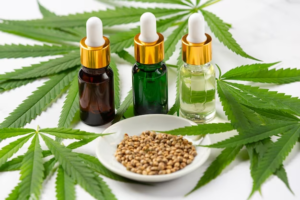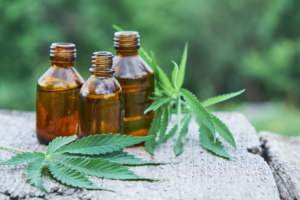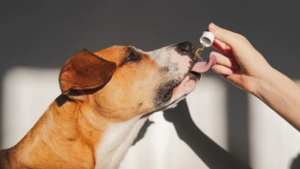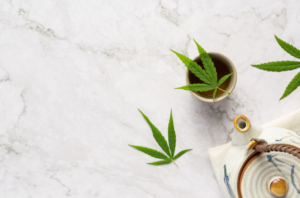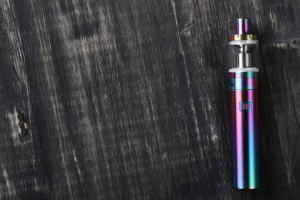
CBD, a compound extracted from the cannabis plant, is available in a myriad of forms – tinctures, topicals, vapes, edibles, and more. Amidst the plethora of information on CBD intake methods, there often emerges a key question: “Is it recommended to drink water following CBD consumption?”
The Interaction between Water and CBD Intake
For those who vape, ingest, or apply CBD topically, drinking water as usual doesn’t impact absorption. However, if you’re using CBD sublingual, it’s best to wait for about a minute before drinking to ensure maximum absorption. Should some CBD remain, your gastrointestinal system will process it similarly to edibles or beverages infused with CBD. Factors like consumption method, CBD form, and even hydration levels can influence CBD assimilation.
Understanding Sublingual Absorption
Beneath our tongues and within our oral cavity lie mucous membranes rich in blood vessels, designed for swift absorption. When swallowed, compounds traverse the extensive gastrointestinal tract before absorption. In contrast, sublingual administration promises quicker effects, potentially being sensed within minutes. CBD is effectively absorbed this way, highlighting the prominence of sublinguality over other methods.
Topical Application of CBD: A Closer Look
CBD, or cannabidiol, has been hailed for its myriad therapeutic properties. While many consumers choose to ingest or inhale CBD, topical application has grown significantly in popularity, particularly among those looking for localized relief and skin health benefits.
How Topical CBD Works
Unlike ingestible forms, topical CBD does not enter the bloodstream. Instead, it works by interacting with cannabinoid receptors near the skin’s surface. The human body’s endocannabinoid system (ECS) has numerous receptors spread throughout, and the skin is no exception. When CBD is applied topically, it binds to these receptors, providing localized benefits.
Benefits of Topical CBD
- Pain Relief: One of the most common uses for CBD topical is localized pain management. Whether it’s joint pain from arthritis or muscle soreness after a workout, CBD creams and balms can provide targeted relief.
- Skin Health: CBD has anti-inflammatory properties, which can be beneficial for conditions like acne, psoriasis, and eczema. Furthermore, its antioxidant nature means it can combat free radical damage, potentially reducing signs of aging.
- Enhanced Absorption with Transdermal Products: Some specially formulated products can penetrate deeper layers, offering not just surface-level relief but also reaching deeper tissues.
Types of CBD Topical
There’s a vast range of CBD-infused skincare and therapeutic products. These include:
- Creams and Lotions: Perfect for moisturizing, as they typically combine CBD with other hydrating ingredients.
- Balms and Salves: More concentrated and are typically used for pain and inflammation.
- Transdermal Patches: Provide a sustained release of CBD over time and can penetrate deeper layers.
- Beauty Products: Such as facial serums, masks, and toners infused with CBD for potential anti-aging and skin-soothing benefits.
Using CBD Topical
Before applying any CBD topical, it’s advisable to clean the area of the application to remove dirt or any barriers that might reduce absorption. Then, generously apply the product, rubbing it in thoroughly. The dosage or amount to apply will largely depend on the product’s potency and the desired effect.
Hydration and Oral Hygiene’s Role in CBD Absorption
Sufficient hydration, accounting for up to 60% of our body composition, is indispensable for efficient bodily functions. Beyond ensuring proper hydration, maintaining oral hygiene by brushing or even rinsing with water can augment CBD’s sublingual absorption. When considering food, while CBD operates effectively on both an empty and full stomach, fatty foods like avocado and fish can boost its bioavailability.

Varieties of CBD Products and Their Relevance
Multiple CBD derivatives exist, labeled as “isolate”, “full spectrum”, or “broad spectrum”. While all are sourced from the cannabis plant, they differ in composition. A full-spectrum extract retains all native plant compounds, while a broad spectrum lacks THC, the psychoactive component. Isolates, as the term suggests, singularly contain CBD. The entourage effect posits that a mix of all cannabis compounds delivers amplified benefits, rendering isolates less effective. Both full and broad-spectrum options are potent, but one’s choice depends on individual preferences and THC’s potential implications.
Key Takeaways from CBD Consumption
- CBD Forms: There are several CBD product types, including tinctures, topical, edibles, and vapes.
- Water Consumption: Drinking water post-CBD intake won’t impact absorption for most consumption methods, but after sublingual intake, a short wait is advised.
- Hydration’s Role: Keeping hydrated ensures smooth bodily functions and could potentially boost CBD’s efficacy.
- Oral Hygiene: A clean mouth can enhance the sublingual absorption of CBD. Rinsing or brushing is advised.
- Food Interactions: While CBD works on both an empty and full stomach, fatty foods might increase its absorption.
- CBD Varieties: Products can be categorized as full spectrum, broad-spectrum, or isolates, each with unique properties and benefits.
- Entourage Effect: A phenomenon suggesting that full spectrum CBD, with all its compounds, can provide enhanced benefits.
- Safety First: Always consult with a healthcare professional if unsure about CBD interactions or if experiencing discomfort.
Comparative Table:
| CBD Type | Contains THC | Composition | Best for |
| Full Spectrum | Yes | All compounds from the cannabis plant including terpenes and cannabinoids | Those seeking the complete range of cannabis benefits without THC constraints |
| Broad Spectrum | No | All compounds except THC | Individuals wary of THC but want most cannabis benefits |
| Isolate | No | Only CBD | Those seeking solely CBD effects or who are sensitive to other cannabinoids |
Potential Side Effects and Their Management
Like any compound, CBD isn’t without potential side effects. A minority of users might experience dizziness, dry mouth, or changes in appetite. It’s crucial to start with a low dose, especially for novices, and gradually adjust. If side effects persist or cause concern, it’s paramount to consult with a healthcare professional. Monitoring one’s reactions and maintaining a CBD journal can aid in optimizing the experience and dosage.
These additions are tailored to integrate seamlessly into the main article while providing comprehensive information on CBD consumption.
The Growing Popularity of CBD Beverages
In recent years, there has been an upward trajectory in the interest and consumption of CBD-infused beverages. From sparkling waters to artisanal teas, the infusion of CBD into drinks is revolutionizing the way many experience the benefits of this non-psychoactive cannabinoid. The primary allure lies in the convenience of consumption. Sipping on a CBD-infused drink can provide the therapeutic benefits of CBD while quenching thirst.
Moreover, as societal acceptance of CBD continues to grow, cafes, restaurants, and even bars are introducing a range of beverages infused with this cannabinoid. These drinks not only offer potential relaxation and anti-inflammatory benefits but also serve as conversation starters, helping to dispel myths and misconceptions about CBD. However, it’s essential to note that the bioavailability of CBD in beverages may be lower than other methods, so understanding the dosage and its effects is crucial for a beneficial experience.
CBD in the World of Athletics
Athletes, both amateur and professional, are increasingly turning to CBD as a natural alternative for post-training recovery. The rigors of intensive training sessions can lead to muscle soreness, inflammation, and even occasional sleep disturbances. CBD’s potential anti-inflammatory properties make it an attractive option to aid in muscle recovery and reduce inflammation.
Furthermore, preliminary research suggests that CBD might play a role in pain management, a significant concern for many athletes. As sporting organizations worldwide continue to revise and update their stance on CBD, it’s becoming more accessible for athletes to incorporate it into their training regimens. As with any supplement, athletes should consult with healthcare professionals to ensure that they are using CBD in a way that’s both safe and effective for their specific needs.
Conclusion
The realm of CBD is vast and continually evolving, with various methods of administration tailored to meet individual needs. From sublingual to inhalation and the burgeoning world of topical, each method brings its unique benefits and considerations. As the CBD landscape continues to grow, it’s paramount for consumers to equip themselves with knowledge. A deeper understanding of how CBD works, especially in terms of absorption and bioavailability, is essential for making informed choices. Whether you’re seeking systemic effects or targeted relief, there’s likely a CBD product suited for your needs. The key is to recognize what those needs are and choose the method that aligns best. As with any wellness product, it’s always advisable to consult with healthcare professionals and conduct thorough research, ensuring you’re consuming a high-quality, safe, and effective CBD product.
FAQ
1. Can I combine different methods of CBD consumption?
Yes, many people combine methods, like using topical for localized relief and tinctures for systemic effects. However, always monitor your total dosage.
2. Are there side effects when using CBD topically?
Topical CBD is generally well-tolerated. However, some may experience skin irritations. It’s always good to test a small area first.
3. How often can I apply CBD topically?
It varies based on individual needs. Many apply 1–3 times daily, but always refer to product guidelines and consult a dermatologist if unsure.
4. Does the quality of CBD products vary among brands?
Absolutely. It’s essential to buy from reputable brands that offer third-party lab test results to ensure potency and purity.
5. Can I use CBD topicals on my face?
Yes, but ensure the product is designed for facial skin, which is more sensitive. Always patch-test first.

